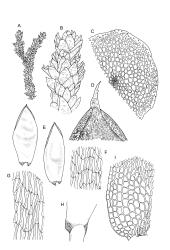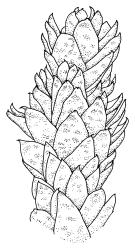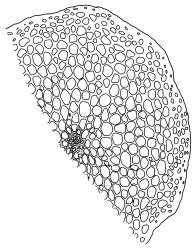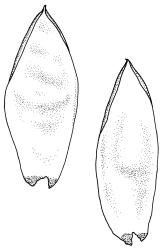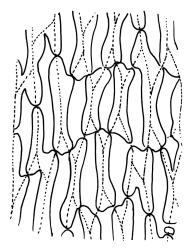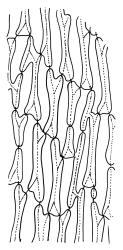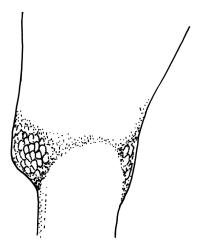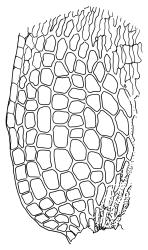- ≡ Hypnum inflatum Hook.f. & Wilson in Wilson, Bot. Antarct. Voy. II (Fl. Nov.-Zel.) Part II, 111 (1854)
- ≡ Eucamptodon inflatus (Hook.f. & Wilson) Mitt. in Beckett, Trans. & Proc. New Zealand Inst. 25: 300 (1892)
- = Eucamptodon inflatus var. neocaldonicus Cardot, Bull. Herb. Boissier sér. 2, 8: 166 (1908)
Plants very robust, bright- or yellow-green above, dark green or brown below, forming erect turves or semi-creeping. Stems quite variable in length, commonly c. 30 to >300 mm, sparsely and irregularly branched and easily fragmenting, in cross-section with distinct but rather small central strand, and many layers of progressively thicker-walled and red-orange outer cells, the outermost with numerous oil-inclusions. Shoots commonly to 8–10 mm wide, often with areas of smaller and more widely spaced leaves below and larger more tightly spaced leaves near tips (sometimes with several alternate bands of smaller and larger more crowed leaves on one branched shoot). Branch primordia numerous, mostly arrested in early stages of growth. Leaves thin and membranaceous, spreading, more crowded near stem and branch tips, very strongly rugose or irregularly wrinkled both fresh and dry, rarely scarcely wrinkled, broadly ovate to broadly elliptic, rather quickly tapered to a small and reflexed acumen, strongly concave especially in upper portions, with the apex abruptly tapered to a tubular, sharply toothed, and ± reflexed acumen; folded weakly inwards at upper margins, entire except for the acumen, clasping but not decurrent at base, c. 5.5–8.0 × (2.0–)3.0–3.8 mm (under cover slip); mid laminal cells linear and ± vermicular, mostly (60–)75–120 × c. 7–9 µm, thick-walled, very strongly porose; cells at apex becoming shorter but otherwise similar; marginal cells not differentiated; basal cells shorter and strongly orange pigmented in several rows; alar cells forming a large and concave group, enlarged, thick-walled, unistratose, and ± quadrate, red- or yellow-brown. Costa mostly absent, occasionally double, ill-defined, and very short (not or scarcely exceeding the pigmented basal cells). Axillary filaments 1–2 per leaf, 6–8 cells long, with basal 1–2 cells square and red-brown, the upper cells short rectangular, and terminal cells enlarged (fide Allen, 1987). Pseudoparaphyllia foliose-ciliate, the basal portion several cells wide, composed of incrassate and porose cells, best seen around arrested branch primordia.
Dioicous. Perichaetia unknown. Perigonia terminal, in discoid splash cups, with outer leaves broad and short, with the apex obtuse and apiculate, and with very numerous coloured quadrate cells in the lower part; innermost leaves very short, much wider than long, tubular, with the apex truncate and faintly mucronate and with the cells shortly oval; paraphyses nil; antheridia numerous, stalked, narrowly clavate, with empty antheridial jackets c. 700–800 μm long and borne on stalks c. 230–400 μm in length. Sporophytes unknown.
Allen 1987, figs. 2–4; Seppelt et al. 2013, pl. 24; Malcolm & Malcolm 2003, p. 57.
NI: N Auckland including offshore islands (RT, GB), S Auckland, Wellington (Wainuiomata); SI: Nelson, Marlborough (Pelorus Bridge Scenic Reserve, Bryant Range), Canterbury (Poulter River), Westland (Croesus Peak, Ōkārito), Southland; Ch (Ohira Bay, Pitt I.).
Australasian. Tasmania*, New Caledonia*.
In the northern part of its range, where it is most abundant, P. inflatus most often occurs over volcanic rocks (especially lava, as on Rangitoto I.), where it commonly forms extensive ("up to 5 feet across") swards and sometimes forms the dominant ground cover. It also occurs in kauri gum lands, and mānuka/gorse scrub, and under regenerating kauri. At Te Moehau (S Auckland L.D.) it occurs on summit rocks and in kauri swamplands and Sphagnum bogs. It is sometimes associated with sites where periodic burning occurs. L.B. Moore described colonies under mānuka and gorse scrub at Silverdale (N Auckland L.D.; CHR 351344.) as "abundant and increasing" in the 1930s, while F.W. Bartlett described it at the same locality (quoted by Allen 1987, p. 341) as "on my property literally cover [ing] acres with a beautiful carpet up to a foot deep." Material from geothermally heated ground near a geyser has been collected from Geyser Valley near Wairakei, and Matt Renner (pers. comm., 15 April 2010) informed me that this species grew on geothermally altered clay around thermal vents in the Paeroa Range near Rotorua (both in S Auckland L.D.). On South I. it is mostly restricted to wetter regions and most commonly grows beneath mānuka (and sometimes dwarf southern beech) in heathland, including pākihi and similar vegetation with impeded drainage. It is documented from numerous localities in both Nelson and Southland L.D., and at some can be classed as abundant (e.g., Te Kuha Ridge near Mt Rochfort, Nelson L.D.). In the Bryant Range it grows over ultra-mafic bedrock. It rarely occurs in lowland mixed podocarp forest (as at Pelorus Bridge Scenic Reserve). On Pitt I. it was collected by P.J. de Lange in 2008 growing in patches in an "ailing Dracophyllum arboreum forest remnant at c. 80 m elev." Commonly associated species include the mosses Campylopus introflexus, Dicranoloma robustum, Ditrichum punctulatum, Rhacocarpus purpurascens, Sclerodontium pallidum, and Sphagnum spp.; the lichens Cladia aggregata, C. retipora, and Siphula decumbens; and the vascular plants Gleichenia dicarpa, Empodisma minus, Dracophyllum spp., and Carpha alpina. On the North I. ranging from sea level (Rangitoto I., North Auckland L.D.) to c. 850 m (Te Moehau, South Auckland L.D.) and on the South I. from 30 m (Pelorus Bridge Scenic Reserve) to at least 1000 m (Denniston Plateau, Nelson L.D.).
Pulchrinodus inflatus is among the most dramatic and conspicuous of New Zealand mosses, albeit one of rather patchy distribution and largely restricted to wetter portions of the country. Its robust habit, very large, membranaceous, and usually strongly rugose leaves, which are often crowded and larger near the stem apices, make Pulchrinodus highly recognisable.
Allen (1987) used the presence of seven characters that he considered to be of "primary importance" (viz., pseudoparaphyllia, rudimentary costae, long incrassate and porose laminal cells, unbranched habit, presence of a central strand, numerous arrested branch primordia, and leaves evenly arranged around the stem) to argue in favour of a relationship to the Pterobryaceae, perhaps near the African genus Hildebrandtiella. While he predicted that a new family might eventually be required to accommodate the genus, he considered the creation of such a family would be premature until sporophytes were located.
The arrested branch primordia, and their associated foliose-ciliate pseudoparaphyllia, are easily observed (although staining is helpful) by stripping the leaves from a portion of the upper stem and examining the naked stem under the stereoscope. The published notes of Allen (1987) have been relied upon for the description of axillary hairs, which have not been seen. Allen’s (1987, p. 336) observations concerning the fragmentation of the brittle apical portion of the stems leading to the release of a subtending primordial branch and its overtopping of the broken stem is consistent with my observations. He suggested that the activation of these branch primordia results in the uneven vertical distribution of leaves that is characteristic of this genus. Both Sainsbury (1955) and Allen emphasised the alternate banding of densely and widely spaced leaves as a feature of the genus. In well-developed plants some degree of banding can nearly always be observed, but this is often an inconspicuous feature in herbarium material; the concentration of leaves at the stem tips is less pronounced than in species such as Ptychomnion aciculare. In stem cross-section the contents of the outermost layer of cells are difficult to observe but appear to have numerous oil inclusions that make them appear papillose.
Male sex organs are rare in Pulchrinodus and I have seen unquestionable perigonia only in herbarium material from Rangitoto I. (W.R. Sykes 146/90, CHR 472452) and from Silverdale (N Auckland L.D., F.W. Bartlett s.n., CHR 40321). My observations on the perigonia in these plants largely agree with those of both Sainsbury and Allen (1987, p. 336). Allen (1987) used information about the terminal perigonium of Pulchrinodus to infer that it is an acrocarpous moss.
The only Tasmanian material examined is a fragmentary collection from Mt Hean in south-west Tasmania (CHR 352750). It is unusual by having very weakly wrinkled dry leaves, and apparently is the same material as that illustrated by Seppelt et al. (2013). There are three other south-western Tasmanian specimens in HO (fide Lynette Cave, pers. comm., 17 Jan. 2017), all from elevations of 700 m or greater. Apart from the Mt Hean collection, all the Tasmanian collections have conspicuously wrinkled leaves "more like the New Zealand material".
There appears to be no type material of Hypnum inflatum present in N.Z. herbaria, but the two collections (duplicates of which were presumably seen by Mitten) cited by Beckett (1893) when transferring this species from Hypnum to Eucamptodon are represented in CHR.
In a N.Z. context, P. inflatus is only likely to be confused with Dicranoloma obesifolium. In P. inflatus the vegetative leaves are strongly rugose, ecostate, or with inconspicuous double costae, and a small, reflexed acumen, whereas in D. obesifolium the leaves are non-rugose, singly costate, and apically rounded. Pulchrinodus inflatus occurs at lower elevations (to c. 1000 m) and is not known with capsules, while the higher elevation (mostly above 1000 m) D. obesifolium frequently fruits.




